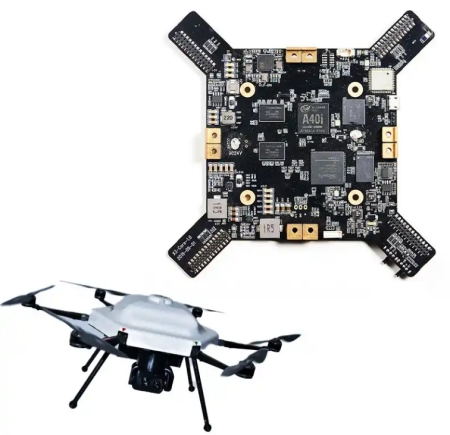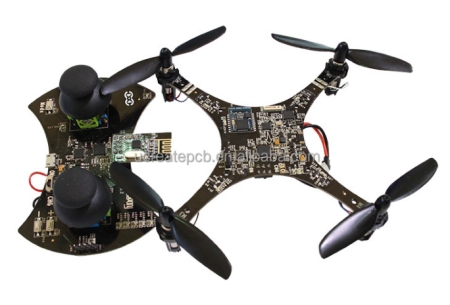Categories
Recent Posts
In the rapidly evolving world of technology, drones have emerged as one of the most transformative innovations of the 21st century. These unmanned aerial vehicles are no longer confined to military applications; they have found their way into countless industries, from agriculture to filmmaking, logistics to environmental monitoring. At the heart of every drone's functionality lies a crucial component: the drone circuit board. In this article, we will delve deep into the world of drone circuit boards, exploring their significance, capabilities, and how they are shaping the future of the drone industry. Whether you're a drone enthusiast, a professional in the drone industry, or a manufacturer, selecting the best drone PCB is paramount to the overall performance, reliability, and functionality of your drone. In this comprehensive guide, we will walk you through the essential factors to consider when choosing the best drone PCB.

A drone circuit board, also known as a PCB (Printed Circuit Board), is the brain of a drone. It is a complex assembly of electronic components that facilitates the communication between the drone's various subsystems, ensuring seamless flight control, data collection, and transmission.
Chapter 1: Understanding the Importance of a Quality Drone PCB
1.1 The Backbone of Drone Functionality
A drone PCB is like the central nervous system of the drone, responsible for coordinating and controlling all its operations. It's crucial for stable flight, accurate data collection, and efficient communication.
1.2 Impact on Performance and Reliability
A high-quality PCB can significantly enhance your drone's performance and reliability. It ensures that the drone operates smoothly, even in challenging conditions, and minimizes the risk of mid-flight failures.
Chapter 2: Key Factors to Consider When Choosing a Drone PCB
2.1 Material Selection
The choice of PCB material plays a critical role in performance and durability. Learn about the different materials available, such as FR-4, Rogers, and polyimide, and how they impact your drone's performance.
2.2 Layer Count and Complexity
Determine the appropriate number of layers for your PCB, considering the complexity of your drone's circuitry. More layers can provide better signal integrity and reduce electromagnetic interference.
2.3 Weight and Size Constraints
Consider the weight and size limitations of your drone, as these factors directly impact PCB design. Opt for a PCB that strikes the right balance between functionality and weight.
2.4 Component Compatibility
Ensure that the PCB is compatible with the components you intend to use, including sensors, processors, and communication modules. Compatibility issues can lead to performance problems.
Chapter 3: Design and Layout
3.1 Efficient Circuit Design
A well-thought-out circuit design is essential for optimal performance. Learn about best practices for layout, component placement, and routing to minimize signal interference.
3.2 Thermal Management
Drones generate heat during operation, and efficient thermal management is critical to prevent overheating. Choose a PCB with appropriate thermal features such as vias, copper pours, and heat sinks.
3.3 Signal Integrity
Maintaining signal integrity is crucial for accurate data transmission and reception. Learn how to design the PCB to minimize signal distortion and noise.
Chapter 4: Quality Assurance and Testing
4.1 Quality Standards and Certifications
Look for PCB manufacturers that adhere to industry standards and certifications such as ISO 9001 and IPC-A-600. These certifications ensure quality control throughout the manufacturing process.
4.2 Prototype and Testing
Before mass production, create prototypes of your drone PCB to validate its performance. Rigorous testing, including functional and environmental tests, can identify and rectify any issues.
Chapter 5: Manufacturing and Assembly
5.1 Choosing a Reliable Manufacturer
Select a reputable PCB manufacturer with a track record of producing high-quality boards for the drone industry. Read customer reviews and seek recommendations.
5.2 Surface Mount Technology (SMT)
Consider SMT assembly for your drone PCB, as it offers greater precision, reliability, and space-saving benefits compared to through-hole assembly.
Chapter 6: Cost Considerations
6.1 Balancing Quality and Cost
While cost is a crucial factor, prioritize quality over price. Cutting corners on the PCB can lead to expensive repairs, replacements, or performance issues in the long run.
6.2 Bulk Ordering
Explore the option of bulk ordering if you plan to manufacture drones in larger quantities. Many manufacturers offer discounts for larger orders.
Chapter 7: Future-Proofing Your Drone PCB
7.1 Scalability
Choose a drone PCB that allows for future upgrades and modifications. Scalability is vital to adapt to emerging technologies and changing requirements.
7.2 Compatibility with Emerging Technologies
Consider how your PCB choice aligns with emerging technologies such as 5G connectivity, AI integration, and advanced sensors.

Conclusion:
Selecting the best drone PCB is a crucial decision that can make or break the performance and reliability of your drone. It's a complex process that requires careful consideration of material, design, quality assurance, and cost factors. By following the guidelines in this comprehensive guide, you can ensure that your drone PCB choice is well-informed and aligned with your specific drone project's needs. Remember, investing in a high-quality drone PCB is an investment in the success and longevity of your drone ventures.
Welcome to consult our sales engineer with BOM list and Gerber file